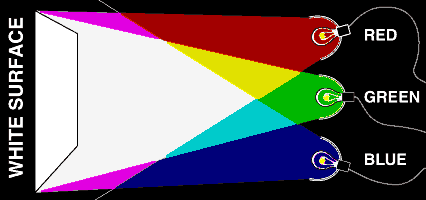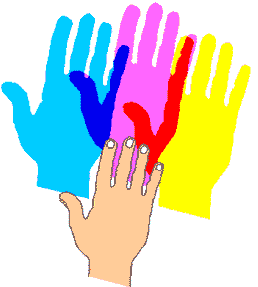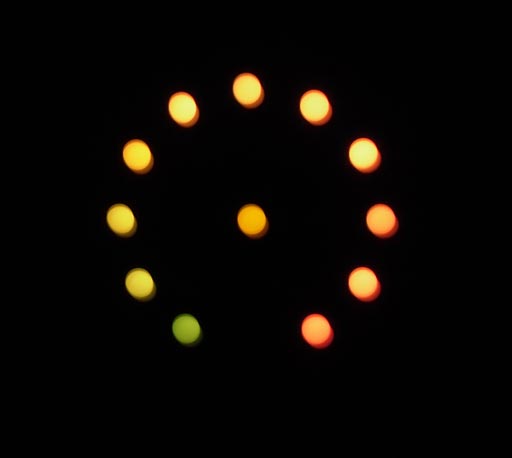
A red, green and blue floodlight shine onto a white wall.
Introduction
Today we'll look at a bit of color.
We'll start by looking at the spectrum of visible light.
Then proceed to create colors by:
adding colored lights and then
subtracting light by using shadows.
Then, after a break, we'll return to learn the rules of color algebra.
Along the way we'll have a chance to visit a few optional exhibits and explorations.
So Let's get started.
Exploration #1 The spectrum of light.
Look at the spectrum of light.
On your own, you can do the activity Project a Spectrum where you will use an overhead projector and a piece of holographic diffraction grating to examine the spectrum. In this activity you will also learn how to use a diffraction grating as a "truth teller for light." to take apart a color you see into the color or colors which make it. You'll also learn how there came to be 7 names for the colors of the spectrum, ROYGBIV...Newton did it! And you'll also learn that there are colors that humans can see that are not in the spectrum!
At the Exploratorium you can sometimes look at the
spectrum of sunlight at the exhibit Solar Spectrum.
If you cannot visit the museum, you can see
a solar spectrum by placing a white piece
of paper in the sunlight, then look at the paper with a Project STAR
spectrometer. Or you can build a spectrometer by going to
http://www.exploratorium.edu/spectroscope.
Diffraction grating for the spectroscope can be purchased from
Edmunds
Scientific or Learning
Technologies.
Science Mulch
1. The element helium, named for helios the sun god, was
discovered by its dark absorption lines on the sun before it was
discovered on earth.
2. The atoms that absorb sunlight and create the dark fraunhoffer lines reemit the light, so why are the lines dark?
Answer: the light is coming only from one direction, from the sun but it is emitted in all directions. So the line is dark.
3. Since the human eye can see the same color when it is looking at two different spectra, I call the use of a diffraction grating to break light up into its spectrum a "truth teller for light."
Exploration #2: Mixing colors of light
This is a summary of the explorations I lead at the colored shadows wall during the summer institute workshops.

A red, green and blue floodlight shine onto a white wall.

A hand placed in front of the white screen casts interesting
shadows.
The exhibit, Colored Shadows only allows us to investigate addition or subtraction of colors on an all-or-nothing basis. We can add one color or completely remove one color at a time.
The Exploratorium computer exhibit, Mix and Match, allows us change the intensity of the colors in steps of 1%.This allows us to investigate colors such as pink, and brown, and pastels in general.
At the Mix and Match exhibit we can talk about hue, saturation, and brightness as description of colors as well as the percent of red, green, and blue.
We can also explore how humans can detect the difference between more than 1 million different colors.
Break
Exploration #3

At the Exploratorium exhibit Seeing Yellow you compare two yellow lights and notice that they appear identical, and yet one of the yellows is created by a single frequency of light, yellow, while the other is composed of two different frequencies, one of which by itself is seen as red, and the other as green. If you compare your perception of identical yellows with those of other people you will see that different people looking at the same color see different colors.
Color Algebra, a way to keep track of all those colors.
I've been throwing around the symbols R,G, B, C, M, Y, K for a while, adding them and subtracting them to make other colors.
Here's an introduction to Color Algebra.
Up to now we have been adding colored lights to make new colors. We can also make colors by starting with white light and subtracting colors. This is usually done with pigments.
In the classroom we investigate the use of pigment colors.
Exploration #4 Pigments of the imagination (under development)
We use water color pens on white paper. By mixing the subtractive primary colors: magenta, cyan, and yellow, we can make other colors. We use Mr. Sketch pens.
Exploration #5 Computer Colors
Optional Explorations
How color vision works
Rods have rhodopsin which light breaks into retinene and opsin releasing an electron and energy. Resulting in a nerve impulse.
Cones act similarly but have different tunings. (Go to driven oscillator exhibit) Most people have 3 cones Red Green and Blue named after their peak response. When the red cone fires by itself you see red, green gives green and blue gives violet! Oh well. Cones are named after the color of their peak sensitivity not after the color you see when they fire alone. When yellow light hits the retina it fires the red and green cones equally and not the blue so you perceive yellow. However red light and green light also fire both cones equally resulting in a perception of yellow. Many different combinations of light can result in the perception of the same color. Even so, you can perceive over a million different colors. This leads to green plus blue looking cyan and red plus blue looking magenta. Of course red plus green plus blue appears white. All your brain can know about light is what is transmitted by the three neurons RGB from each point on the brain.
How the Retina Works, A more detailed explanation of the electrochemistry of the cones.
Visit the Exploratorium Exhibit Seeing yellow
This exhibit answers the question, Does everyone see the same colors I do? The answer is no.
Seeing yellow: Yellow can be made by one wavelength of light or a blend of wavelengths. (Red plus green for example.)
This exhibit allows you to blend red and green to make a yellow which is indistinguishable from a one wavelength yellow. Someone else however might see your exact mix as a different shade of yellow. This is the way psychologists test for color perception, and show that different people see the same color differently.
Visit the Exploratorium exhibit Color removal
This is reproduced in the classroom using a diffraction grating by Project a Spectrum
The exhibit uses prisms, the classroom version uses diffraction gratings.
Do the Red-green activity where you look through filters at color photographs.
Additional exhibits relating to color:
Anti Slit, by projecting the spectrum of an anti slit, a slat, you remove one color at a time from the spectrum of white light creating a "spectrum of subtractive color.
Bird in the Cage, an exhibit snack which shows afterimages in the complementary colors to the original image.
Benham's Disk an exhibit snack which produces the perception of color by rotating a wheel with black and white segments.
Resources:
The Project STAR spectrometer is available from Learning Technologies Inc., 40 Cameron Ave., Cambridge, MA 02140 phone 617-628-1459
A set of wonderful links to color and vision
|
Scientific Explorations with Paul Doherty |
|
10 May 99 |